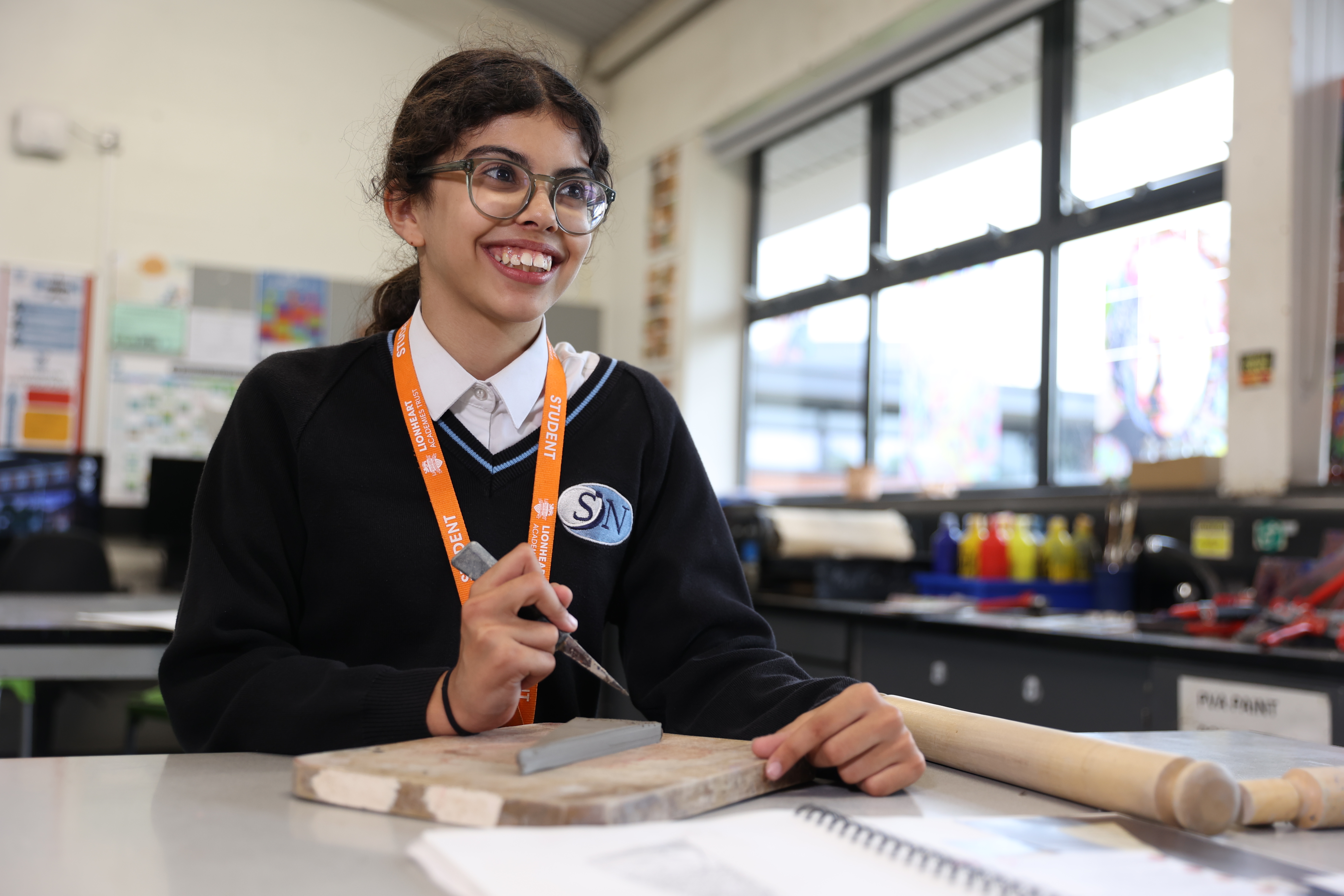
Art
Art and Design, instilling a genuine passion in our students and developing inquisitive, confident and resilient learners through experiences that allow them to gain an understanding of the world around them and themselves.Curriculum rationale
We have a moral obligation and responsibility as educators to prepare young people to engage in the wider world around them. Art and Design is a creative platform in which students can access, enjoy and thrive. Our curriculum is built on a secure foundation of skills and knowledge which challenges learners to become independent practitioners through an iterative process of reflection and refinement.
Our specialist art classrooms, digital suite and ceramics facilities allow students to study drawing, painting, ceramics, mixed media, printing, digital art and photography. Our KS3 curriculum is designed to engage, inspire and challenge pupils, equipping them with the knowledge and skills to experiment, invent and create their own works of art, craft and design. We provide a rich and diverse learning experience which exceeds the requirements of the National Curriculum, providing our students with many opportunities to develop and refine practical skills. Our learners are encouraged and nurtured to become more confident when developing new ideas and concepts through critical understanding. We aim to develop the personal attributes of all our students in order to enhance their identity, independence and individuality. We believe that a student’s personal journey of creative and discovery will enhance confidence, embed learning and support them beyond the classroom into adult life.
Curriculum Design
Our curriculum has been designed around the introduction to the elements of visual language and the development of this within the fundamentals of; drawing, painting, 3D Art and the appreciation of artists’ work past and present. The curriculum is predominantly practical and aims to engage students in the activity of creating work for as much of their time in the classroom as possible. We believe that the teaching of the practical element should be taught alongside both historical and contemporary art theory. It is important that we develop the practical skills that will inform and strengthen students’ wider understanding and appreciation of art in all its forms.
At KS3 Students will indefinitely, experience a broad curriculum, enriched with creativity, allowing them to develop ideas more successfully throughout their onwards journey at SJNGC.
Curriculum Plan
Key Stage 3
Art & design is taught on a rotational basis alongside the other design and technology subjects. Students have approximately 9 x 1 hour and 40 min lessons during each year at KS3. Assessment is regular and uses a model personalised to our curriculum allowing students to make rapid progress and take ownership of what is required from them to progress to the next step. During their final year at KS3, students choose whether they would like to opt for GCSE Fine Art.
Year 7
| Topic | What will students learn by the end of the topic | Assessment | |
|
Taught on a rotation with Design and Technology
9 x 1 hour 40 min lessons |
Natural Formal Elements
|
Students are taught to apply skills in relation to the formal elements of art and design with the focus being the natural world. Students build knowledge and skills, working through a series of explore, create, make evaluate tasks developing understanding of line, colour, tone, pattern, texture, shape & form. Students will study the artists Olga Gamynina & Yellena James, analysing their artwork and responding creatively. Students will also learn about health and safety in the art rooms. |
Formative assessment throughout lessons to inform intervention. Summative assessment of overall project at the end of the topic.
|
Year 8
| Topic | What will students learn by the end of the topic | Assessment | |
|
Taught on a rotation with Design and Technology
9 x 1 hour 40 min lessons |
Portraiture project
|
Students explore a range of portrait artists developing pencil skills and observational drawing skills. They will learn about the work of artists Mark Powell, Delita Martin, Natilie Foss, Neomi Saffir & Frida Kahlo and will experiment with different mediums in response. They will learn about collage techniques as well as working with oil pastels and chalk pastels. They will experiment with a range of paints including watercolour, gouache and acrylic. |
Formative assessment throughout lessons to inform intervention. Summative assessment of overall project at the end of the topic.
|
Year 9
| Topic | What will students learn by the end of the topic | Assessment | |
|
Taught on a rotation with Design and Technology
9 x 1 hour 40 min lessons |
Land Sea & Air
|
Students create a series of natural form studies and learn how to present in an A3 sketchbook. They will learn about a range of artists who use the environment around them as inspiration. Students will analyse and explore the work of architect Antoni Gaudi responding with a 3d ceramic final piece. |
Formative assessment throughout lessons to inform intervention. Summative assessment of overall project at the end of the topic.
|
Curriculum Assessment
KS3 students will have regular, low stakes diagnostic tests to check understanding and allow teachers to address misconceptions. These assessments allow teachers and students to identify areas of strengths and areas to improve.
Extra-curricular opportunities
Summer Arts Festival we host an art exhibition inviting family and friends in to view classwork
Afterschool art club exploring digital art, clay, glass work and also set design for any upcoming school productions.
Art and Design competitions
Essential equipment
All equipment is provided. This includes a printed sketchbook for each year. It is however expected that students have the basic classroom equipment for their lessons.

